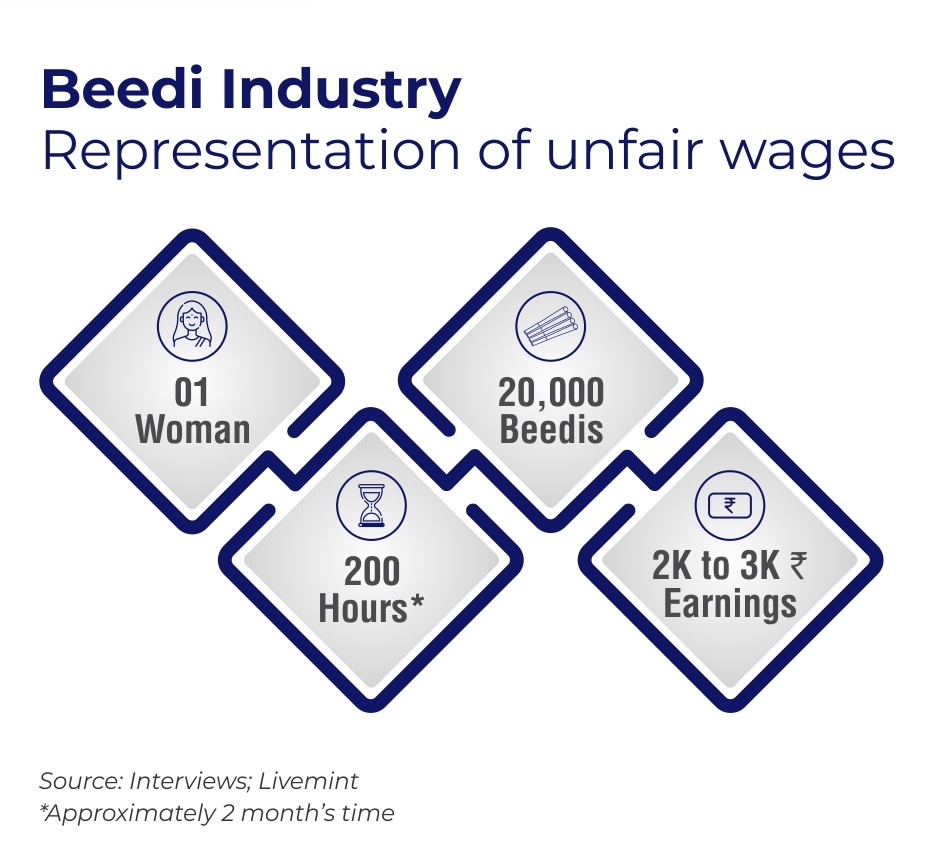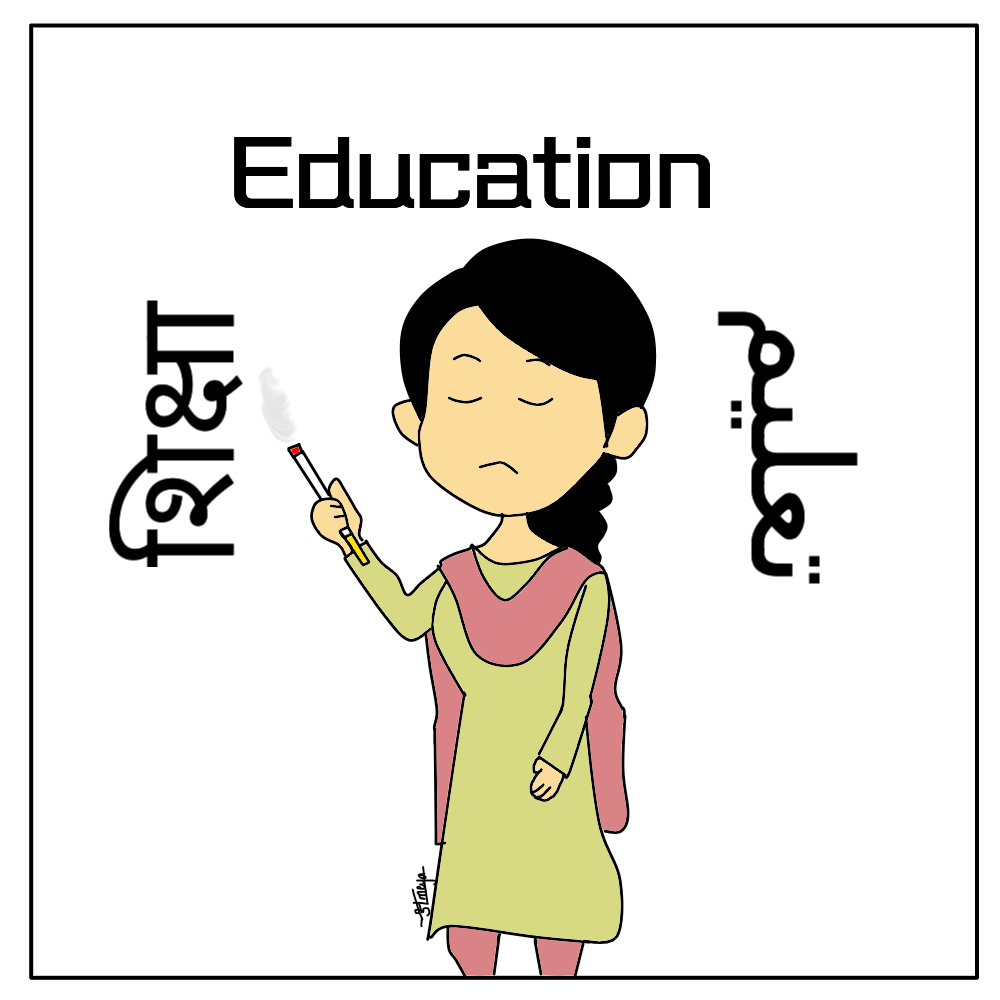July, 2020
Life of a female beedi worker in 21st century India
5 minutes read
The tobacco smoking industry- comprising cigarettes, cigars, pipes, and beedis has witnessed a rapid increase in manufacturing and consumption, thanks to the many perceptions the practice has been able to garner. However, there is a variety in consumers’ perception. Some perceive it as a necessity, to feel intoxicated and suppress the impact of their current living/work conditions, or to combat natural weather conditions. Some perceive it as a status symbol. Some might perceive it as a pleasurable activity and participate in it for fun or due to peer pressure. However, the form in which tobacco is being smoked has a large variety. In this article we make an attempt to explore the working conditions of a worker employed in the beedi-making industry, specifically and what this employment means to them.
The increasing competition in the tobacco smoking industry as a whole, has led to a massive decline in the consumption of indigenous beedis which once held their stage in India and some of our neighboring countries. The simple process of carefully spreading tobacco over a tendu leaf (most of which was found in Madhya Pradesh) and gingerly folding it to tie with a cotton thread, ready to smoke has been a fairly common practice, recognized since the early 20th century. This process of making or rolling a beedi has been and continues to be manual in nature. However, for a few decades now, this industry is facing threats due to increasing competition by multinational brands of cigarettes and the consequent change in consumer preferences. Given such a scenario, we also need to consider that this industry is not really null and void and that it continues to cater to a certain consumer base.
We got in touch with a woman who works in this industry and spoke to us about their work. This article in no way tries to generalize the findings of the data collected from this singular interview. We have tried to present it in as objective a manner as possible, and acknowledged the relative privilege of the researcher when compiling these meaningful insights. Read on to find more about her personal experiences in relation to her work and more importantly, her individual aspirations.
~
Drishti has been contributing to the beedi-rolling industry by working from home since the past 2 years. Her mother-in-law and her are the two women from her family who roll beedis every day and on average, without any food preparation for their family of 10 or other household chores, she is able to roll about 500 to 600 beedis. When there is an influx of household work, she rolls a lesser amount. When asked if the lesser amount she mentioned would be about 100 beedis, she laughed and said that she can manage about 150-200 beedis at least. In 2020, before the lockdown was imposed in her locality she prepared approximately 20,000 beedis. Moving on from numbers, I tried understanding her conditions of work and how her day looks like, especially since her workplace and home aren’t different.

Work conditions and Employer relations:
She shared some excerpts from her day, the predetermined system of her wages and what calls for extra work from her end. She begins her day as early as 5 am in the morning and finishes all her household chores including breakfast and lunch prep. She takes to rolling beedis and preparing them at 10 am. This goes on for 3 continuous hours till it is time for her to serve lunch- at 1 pm. Post this, she rests for a while and devotes another hour or two to prepare beedis. During certain seasons or festivities when there is a heightened need for finances at home, she has to devote extra hours to her work and produce as many beedis as necessary to procure her required income. When asked if she gets her promised remuneration, she was affirmative. She went on to add that her employer has not been unfair to her in terms of wages at all. On trying to gauge her awareness of the BWWF- Beedi Workers Welfare Fund Act (1976) and other such funds and provisions specific to the industry, she shared that she never had to learn about these things. This is because the women from her family- her mother-in-law and her husband’s aunt were always engaged in this work to support their families.
How did she start work in this industry?
She got married 2 years ago and her mother-in-law who is already engaged in the rolling of beedis, initiated her into this work. She perceives this as her contribution to the family, “Rozi-roti kamaane ke liye karna padta hai”. There are 3 people from her family, herself and her mother-in-law excluded who bring in a regular income. So her job is taken as an additional support to keep the family going. She was not a part of this job before she got married but shared no complaints in the course of our conversation. She doesn’t have her own children yet, however there are other children in the family. When asked if they take help from the children for their work, she refused and shared that they spend most of their time in school or with their friends.
Education and Aspirations

Drishti completed her education till the 8th grade, and is fluent in Hindi. She can read and write Hindi and some basic English. She can write her name in Urdu and can understand some Islamic scriptures. She can understand some basics of Bhojpuri as well. Towards the end of our conversation, when asked about what she aspires for and what would she do in case she didn’t have to work, she asserted that she wanted to learn more but her parents could not afford her education. She helped in household chores before she got married.
When probed about the challenges she faces or if there are any health hazards that have affected her by virtue of her job, she replied that there are no challenges as such. She further went to share how it is not a dangerous job as she gets to choose her work hours and work from home while also being able to financially support her family. She did go on to say that she would prefer some upskilling, should the opportunity present itself. However, when asked the specifics of what she would like to engage with, she said she would like to be a tailor. Tailoring is another profession that she can adopt while still staying within the confines of her home and managing her household responsibilities.
What does data have to say?
Some data insights reveal that more than 90% women respondents of a study conducted in 2015 said that they partake in this occupation because it is their only source of livelihood. However, this singular interview revealed how Drishti* worked to support her family which is another claim that some women respondents to the aforementioned study also made.
Another parallel that can be drawn is in terms of preferences of upskilling.
The seeming over-representation of women in the informal sector of the beedi industry is because this industry has a USP. It is largely home-based and that works as an advantage for several women engaged in this work since they can diffuse work and home boundaries more flexibly.
It is observed that when it comes to learning and taking on other occupations, some women prefer entering the Garment and Textile industry as tailors if it allows them to work from home. This ensures that they stay within their permissible conditions of work, at the same time escape the hazardous nature of the beedi-rolling job.
COVID-19 and Work:
As we came to the end of our conversation, she shared the impact of COVID-19 on her occupation. She shared how her employer told her that there won’t be work for her during this lockdown period and did not give her a definite period of time. Further, he shared this crucial piece of information with her only after she went to inquire at his office. When she asked for compensatory payment, he extended some monetary help which has not been able to sustain her family sufficiently in this period. We ended our conversation with her sharing how she wished for work to resume soon so she could go back to supporting her family.
The conversation revealed several trends that were present in the available academic literature about this industry and its women workers. However, it also provided meaningful insight into her perceptions and motivation to work and most importantly, on some aspirations that are unfortunately curbed within the household.
References
- Remote interviews conducted by the team at Women’s Identity and Progress
- Pulitzer Center: Fading Fingerprints, 2020
- UTMS, Journal of Economics: Socio-economic status of women beedi workers in Bundelkhand region of Uttar Pradesh: An empirical analysis, 2015
- International Labour Organization: Beedi Sector in India, 2003

[…] Beedi industry employs women in home-based work primarily. According to a research study undertaken by AF Development Care, 96% of the total beedi workers […]